Simple CPU Design
CS 441 Lecture, Dr. Lawlor
Silicon FET Transistors
Modern transistors are FET transistors:
you charge up a small channel called the "gate", and it conducts
current between two terminals. In an "n-channel FET", the gate
already has plenty of electrons, so you need to discharge them with a
positive voltage to allow it to conduct. In a
"p-channel FET", you open the gate with a negative voltage. I
like Wikipedia's pictures for these: n-channel is a positive logic
input, and p-channel is an inverting input with an inverting circle.
You can build logic gates from FET transistors quite easily in a "totem pole" configuration. Here's an inverter:

When A is positive, it turns off the high gate, disconnecting Q from
positive voltage (Vdd); and turns on the low gate, connecting Q to the
negative voltage (Vss): A positive makes Q negative. When A is
negative, it turns on the high gate and off the low gate, connecting Q
to positive voltage and disconnecting negative voltage; A negative
makes Q positive.
Here's an AND gate built from FET transistors, and the corresponding silicon implementation:


It's quite easy to build all the logic gates with FET transistors!
Circuit Simulation via TkGate
We're really not going to do spend much time designing actual digital
circuits (this isn't an EE course!), but it's important to understand
the general way digital logic circuits work.
The easiest way to do this is to just play around with circuits for a
few hours. I've prepared the examples below using TkGate, a UNIX-ey
open source digital logic designer and simulator.
- In Windows, TkGate is only available via the UNIX compatability layer Cygwin, but it is built in to Cygwin.
- In
Linux, TkGate is often available from your package manager (in Ubuntu,
"sudo apt-get install tkgate; sudo ln -s /usr/bin/
/usr/share/tkgate-1.8.7/libexec").
- In MacOS X, supposedly TkGate can be built from source, which you download here.
The TkGate Documentation is pretty good, and the program runs a simple tutorial when you start it.
Many other circuit simulators exist. In EE 341, I used "LogicWorks",
which is a fine commercial program for Windows and MacOS. Sadly, translating
circuits between two graphical simulator packages is only rarely possible!
Simple CPUs built from Digital Logic Circuits
Here are a few steps on the evolutionary path to a CPU:
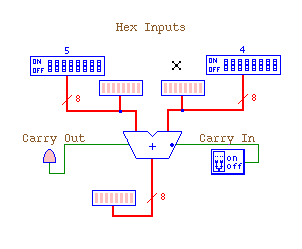
First, an add circuit. We've set up two 8-bit hex input devices
(DIP Switches) in TkGate, hooked them to a Make -> ALU -> Adder,
and displayed both input and output binary data in 8-LED arrays.
Click the above circuit to download the TkGate Verilog-style circuit
description.
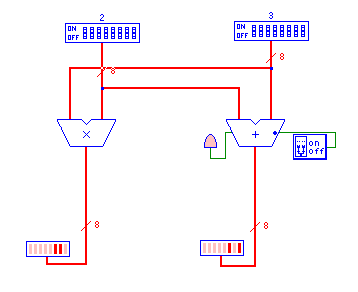
Here's almost the same circuit, except now we run the input values past a multiply circuit as well as the adder.
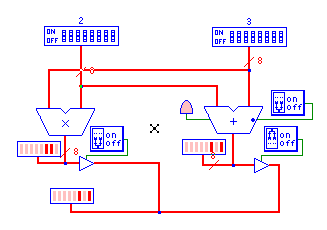
Now we've added a "bus". The little three-input triangles below each arithmetic unit are "tri-state buffer/drivers",
which enable us to turn the add and multiply outputs on and off, and so
combine the outputs of these two circuits. The idea is we turn on
the output we want, which at the moment we do manually, by flipping the
appropriate output switch. If you turn multiple outputs on at the
same time, or turn no outputs on, TkGate shows a yellow indeterminate
output state. In real circuits, driving a bus to several
different values causes the buffer drivers to heat up and possibly fry
themselves!
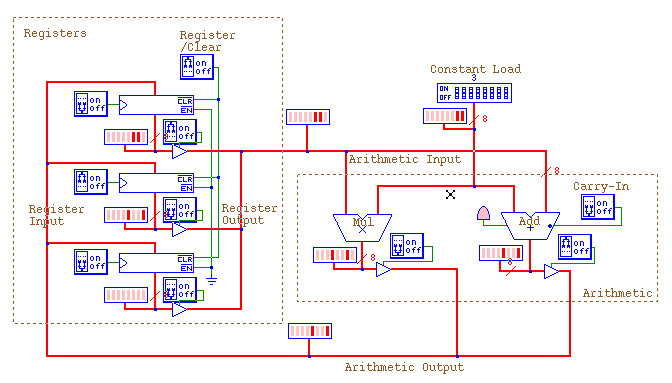
Now we add a set of "registers", which are just data storage
elements. We hook up the output of each register to a tri-state
driver, and use the drivers to select which register we want to read as
input. We hook up the data input to each register to the
arithmetic output bus. Finally, we can manually "clock in" the
arithmetic result into any register (via the triangle-shaped register
inputs).
Annoyingly, TkGate starts all the registers in indeterminate (yellow)
state, rather than zero, so we have to manually clear the registers at
simulated startup by flipping the register clear switch off and then on
again.
OK, now we're approaching a real CPU! The only thing we're
missing is a control unit that will flip all the switches appropriately
to execute some instructions!
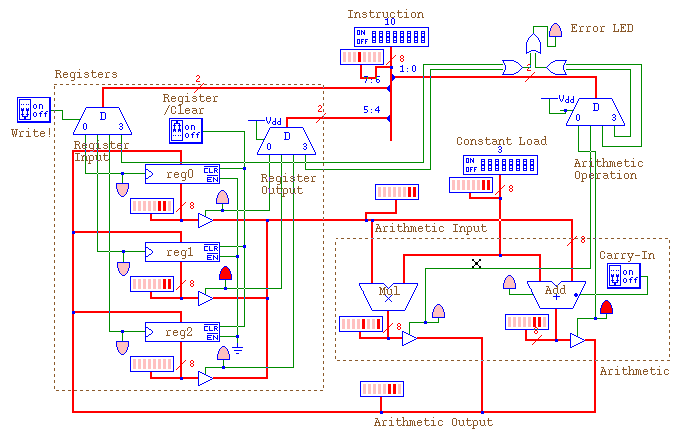
The big trapezoidal "0 D 3" modules are called decoders
(also known as demultiplexors or demuxes). They take a binary
input value (the red bus going in the top), and copy the left input to
one of the four outputs along the bottom. We've wired these mux
outputs to the input lines of our arithmetic bus, register output bus,
and register input bus. This means that rather than manually
flipping switches, we just need to load a binary number into the
"instruction" register!
In this case, we've connected bits 1:0 (the low two bits) of the
instruction to the arithmetic operation demux. So if the low bits
are 00, the add circuit turns on. If the low bits are 01, the
multiply circuit turns on. Bits 5:4 (the low two bits of the high
hex digit) connect to the register output. So 00 means output
register 0 to the arithmetic input bus, 01 means output register 1, 10
means output register 2, and 11 is an error. Finally, bits 7:6,
the high two bits of the instruction, connect to the register input
control lines. To write to register 0, the high bits should be
zero, and so on. You need to manually flip the "write" switch to
make the registers write (this avoids annoying circuit race conditions).
So overall, this CPU's instructions look like:
<destination register: 2 bits>
<source register: 2 bits> <unused: 2 bits>
<operation: 2 bits>
<constant: 8 bits>
For example, the instruction (hex) "40" (binary 0100 0000) writes to register 1, reads from register 0, and adds.






